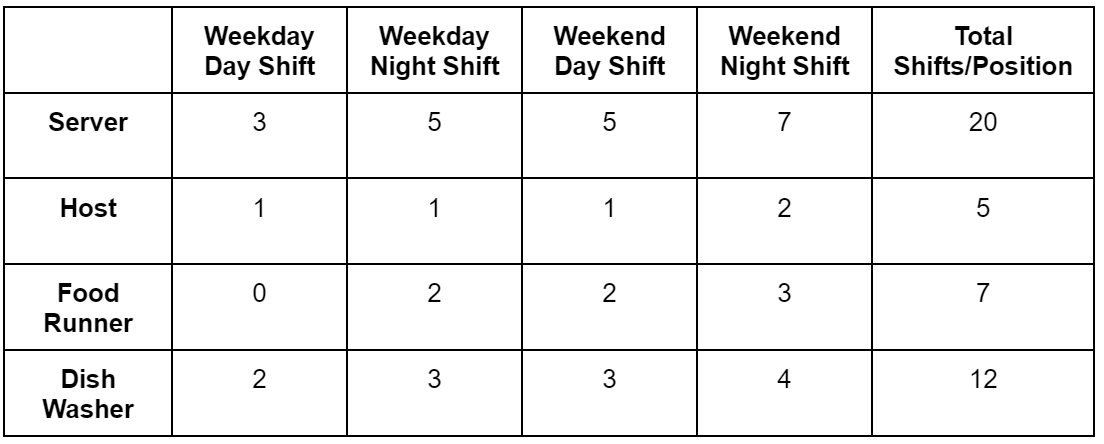How to Create Your Restaurant’s Staffing Plan

TL;DR
- The restaurant industry is one of the most competitive industries for staffing with unprecedented shortages.
- Creating a staffing plan can help you narrow down your staffing needs and help you focus on shifts that need to be filled the most.
- With a simple three-step process, you can find out how many employees you need for your restaurant to run smoothly on a weekly basis.
- Follow the steps below to complete the three-step calculation, which requires you to take inventory of the necessary roles and shifts for your restaurant operations.
Introduction
Staffing in the restaurant industry is a complex equation that never seems to have a definite answer. Some shifts you’re overstaffed, others you’re understaffed. Sometimes you have a stacked roster of employees and other times it seems like there’s never enough people to fill your open positions.
Hiring has always been challenging, but now it’s even tougher with notorious labor shortages. All restaurants are feeling the effects, and thankfully there’s a simple equation to help you figure out exactly how many employees you need for your weekly operations.
With a little bit of math, you can calculate your restaurant’s exact staffing needs to help you better direct your hiring efforts.
If you’re not a fan of crunching numbers, then thankfully we live in a day and age where technology can make almost anything easier. For those interested, there’s hiring software available that can ease the process by automatically showing you insights into your scheduling trends.
Regardless, it’s always beneficial to know the manual way of doing things. Read on to learn how you can calculate your employment needs with a simple three-step calculation.
How Many Restaurant Employees Do I Need?: Our 3 Step Calculation
Using data for decision making is a smart business decision. So, the team at HigherMe took to the drawing board to create an equation that gave our clients the answers to their staffing needs.
With a simple three-step calculation, you can easily find how many employees you need for your business operations. This helps you ensure all the roles at your restaurant are properly filled, which will in-turn provide your customers with better service and a more quality experience.
This information proves itself invaluable, especially during a time with unprecedented labor shortages. Restaurants are having to meet demands with less, and this calculation definitively tells you if employment is worth an investment with scarce resources.
Step 1: List All Necessary Roles
The first step to finding out how many employees you need is to first outline all the necessary roles in your restaurant.
This means listing all positions—including both front-and-back-of-house-staff—that are required for your restaurant to run smoothly.
This list might include:
Front-of-House
- Restaurant manager
- Server
- Food runner
- Busser
- Bartender
- Host
Back-of-House
- Kitchen manager
- Head chef
- Sous chef
- Line cook
- Dishwasher
Step 2: Build a Sample Schedule
Building a sample schedule helps you see the staffing needs of your restaurant on paper. It may seem it a little daunting, but it can easily be done in a few simple steps:
A. Start with opening hours:
When building your sample schedule, it’s best to start with your opening hours and work your way to closing in shifts of 8, 10, or 12 hours. If you’re open later on the weekends, then you’ll need to add on extra shifts to accurately represent your restaurant’s schedule.
Next, calculate the total number of shifts required of your restaurant every week and group them by type, like day shifts, evening shifts, and weekend shifts.
B. Break up shifts by type:
Next, break up your shifts by type and calculate how many roles are required for each shift.
Start with the day shifts and work your way down the necessary role list you made in step one. Make sure to tally how many of each position you need for the shift to run smoothly. The number of staff required may fluctuate depending on if it’s a higher trafficked day.
To help you figure this out, you could consider the ratio of staff to customers. If you keep this ratio constant, you shouldn’t see any impact to the level of service and the dining experience during busier shifts.
C. Add up all the shifts:
Once you have outlined how many positions are required for each shift for each day of the week, you can tally up your total shifts by position.
This will show you how many dishwasher shifts, for example, need to be filled each week for your restaurant’s weekly operations.
To move on to the next step, total all of your shifts by position. For example, here is a mock table:

Step 3: Compare Total Shifts with Your Roster
You now have the total amount of shifts required of your restaurant per week. Now, it’s time to cross-reference the list with the staff you have now.
For example, if your restaurant requires 30 server shifts per week and your servers average five shifts per week, then you need six servers for your restaurant to run smoothly. However, it would be wise to have seven servers on your roster to give you some slack in your scheduling and to accommodate any servers who would prefer four shifts rather than five.
Continue this same calculation for every necessary role on your list. From here, you can see how many shifts you’re short-staffed and where you need to focus your hiring efforts.
Conclusion
Hiring the right employees isn’t an easy task, especially in such a competitive and demanding industry. Restaurant managers have to work even more strategically to find and retain skilled employees to meet growing business demands.
Taking inventory of your staff and the required positions of your restaurant can help you gauge where you're short-staffed and where you should focus your hiring efforts. If you wish there was an easier way, then hiring software can help streamline your data and show automatic insights into your scheduling trends.
Whether you prefer calculating your staffing needs manually or using an automated software like HigherMe, we hope this guide has helped you create a staffing plan and narrow down what roles you need to hire for your restaurant’s overall success.
FAQ
How many staff members should a restaurant have?
On average, a fast-food restaurant will need between 5-15 employees during every shift.
Full service restaurants, on the other hand, will need between 10-40 employees during every shift. This is because full service restaurants require more employees to fill front-of-house positions and additional waiting staff, such as hosts, food runners, servers, and bussers.
How do I calculate how much staff I need for a restaurant?
To explain the calculation you can follow along the table below. Each column is identified with a letter from A to E.
First, decide how many employees for each role are required during a shift (Column A) and count the number of shifts you have per week (Column B). In a second step, calculate the total number of shifts by multiplying weekly shifts by employees needed per shift (Column C).
In a third step, estimate how many weekly shifts you expect employees to take on average. (Column D). Finally, divide the total shifts by the number of shifts per employee to know how many employees you need to hire to staff your restaurant.

Did we miss anything? If you’re ready to start hiring amazing employees, reach out to us at HigherMe! Email us at contact@higherme.com, or visit our Applicant Tracking System!
Test

"Being able to depend on a consistent stream of applications without having to devote hours a week to recycling the same posts has revolutionized our HR workflow, saving me hours of labor."
Book a demo
We'll contact you as soon as possible to better understand how we can help you
